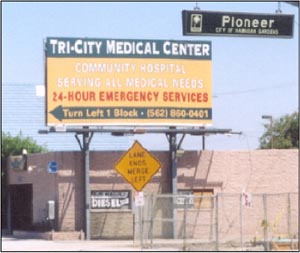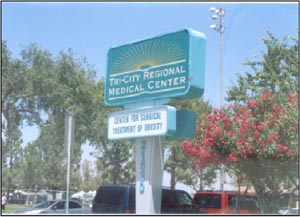Dr. Moskowitz,
it seems, has engaged in non-profit profiteering in Hawaiian Gardens.
Since posting this report on our website, more information has come to light that strongly suggests that Moskowitz's non-profit Tri-City Regional Medical Center is in violation of Internal Revenue Service rules qualifying health care providers for tax-exemption. (Click here to read more…)
Putting
the 'profit' in Non-profit healthcare
 |
|
Tri-City
Hospital sign greets motorists entering Hawaiian Gardens saying
the "community" facility serves all health needs
- as long as you're not poor or pregnant.
|
Take Tri-City Regional
Medical Center in Hawaiian Gardens.
In 1996, when
its balance sheets were beginning to look less-than stellar,2
Moskowitz decided to spin off this privately owned hospital as a
non-profit, while retaining ownership of the building and land.3
Immediately after converting Tri-City Regional Medical Center into
a non-profit, the Irving I. Moskowitz Foundation4 donated
$4.9 million in tax-free proceeds from its Hawaiian Gardens bingo
to the hospital.5 Moskowitz then began collecting the money
back by charging the hospital $95,000 a month in rent, payable to
his private landlord company.6 Those payments now exceed
$110,000 per month.7 California state financing records show
that in 2000 the foundation made an additional transfer of funds
to Tri-City.8
The hospital's
fidelity to the concept of charitable trust9 is tenuous at
best. This could perhaps be forgiven if the hospital was meeting
the health care needs of the local community. But despite its non-profit
status, Tri-City is less than solicitous when it comes to the health
of Hawaiian Gardens.
When the hospital applied for non-profit status in 1997, it made
a commitment to provide pre-natal care.10 Recent patient
discharge data published by the state of California shows that Tri-City
has stopped delivering babies - none were born at the hospital in
either 2000 or 2001.11
It isn't for lack of demand for services. Last year residents of
Hawaiian Gardens brought home 98 newborn babies.12 While
small in size (the city's population is a little under 15,000 13),
Hawaiian Gardens is a young, largely immigrant community - recent
census data indicates the average age of its resident is 26. More
than half of the households have children under the age of 18. And
as of 2000, a little more than 10 percent of the population was
under the age of 5. The women of Hawaiian Gardens are having babies
- they are just not having them delivered at the hospital in their
own neighborhood.
Tri-City's failure
to fully address the health care needs of the poor may be a factor.
Again, nearly one out of every four resident of Hawaiian Gardens
lives below the poverty line and many are immigrants who do not
qualify for state programs such as MediCal (although MediCal is
available to cover prenatal care and deliveries for undocumented
immigrants, making the hospital's failure to provide these services
all the more shocking).
 |
|
Stomach
stapling accounts for a large part of Tri-City Hospital's
tiny patient census.
|
When it turned
non-profit the hospital made a commitment to provide free or reduced
cost care to the indigent 14- and yet in recent years Tri-City
has provided zero dollars in charity care.15 State health
care data shows the other four non-profit hospitals of comparable
size in LA County provided a combined total of two million dollars
in charity care in 2001 (the most recent year that statistics are
publicly available).16
Tri-City's failure
to pull its own weight when it comes to helping out poor patients
has little to do with its bottom line - in 2001 the hospital's gross
patient revenue exceeded $72 million and its net income was slightly
more than two million dollars - despite the fact that its occupancy
rate in 2001 was an abysmally low 19.6 percent.17 The average
occupancy rate for other hospitals of comparable size in the state
of California that year was 52.16 percent.18
How does the
hospital manage to stay afloat with such low patient volume? The
answer may be as close as the sign in front of Tri-City's main entrance
announcing it is also the home of "The Center for the Surgical
Treatment of Obesity."
Tri-City, it
seems, has gotten into the lucrative business of stomach stapling.
The Center,
run by the somewhat famous Dr. Mathias Fobi provides surgical stomach
shrinking services to patients clinically termed morbidly obese,
that is, those who are 75 to 100 pounds or more overweight. (In
what is perhaps an unfortunate display of poor taste, his website's
motto is "lighten up." 19) According to a CBS News
Report profiling his practice, Fobi performs surgery on up to 600
patients a year.20
While Fobi charges
for the surgeries he performs, the hospital also bills patients
for the use of its operating and recovery rooms and other medical
services it provides. In 2002 patients who underwent the surgical
procedure at Tri-City, on average, racked up $50,000 in hospital
charges.21
State health
care data shows that at least 439 Tri-City patients underwent the
stomach stapling procedure last year, that is, more than one out
of every four patients that received some sort of surgical treatment
at the hospital had their stomach stapled.22 Total charges
for those patients was $21,936,400 - representing close to a third
of the hospital's gross charges for the year.
Tri-City's 2001
income tax forms (the most recent that are publicly available) indicate
that by far its highest paid independent contractor that year was
FOCA Management Company, a private company registered to Dr. Mathias
Fobi.23 Tri-City paid Fobi's firm $2,293,044 - more than
its next four highest paid contractors combined.24
Dr. Fobi has
made numerous national television and radio appearances touting
his surgical techniques and his patients come from as far away as
Alaska,25 but the obesity center appears to be of little
value to the community where it is based: last year not one Hawaiian
Gardens resident made the short trek across this mile-wide city
to receive the procedure.26
One former City
Council member recalls that when the hospital was first built, Hawaiian
Gardens welcomed it as the solution to the community's unmet health
care needs. But citing the high cost of treatment at Tri-City and
the lack of charity care, he said few use the hospital now. State
health care data backs that assertion up - despite its proximity
only 13.7 percent of all Hawaiian Gardens residents who were hospitalized
in Los Angeles County last year were admitted to Tri-City Regional
Medical Center.27 Hawaiian Garden residents admitted to the
hospital represented an even smaller percentage of Tri-City's total
patient census - just 5.4 percent.28
Since posting this report on our website, more information has come to light that strongly suggests that Moskowitz's non-profit Tri-City Regional Medical Center is in violation of Internal Revenue Service rules qualifying health care providers for tax-exemption. (Click here to read more…)
Banking
on Bingo Bucks
Moskowitz earns more than $1.3 million dollars annually as landlord
of what is ostensibly a non-profit hospital. But his money-making
off non-profits doesn't end there.
In 1988, the
city of Hawaiian Gardens granted the Irving I. Moskowitz Foundation
a license to operate a non-profit bingo within its city limits in
exchange for a commitment to spend the majority of the funds generated
by the bingo on the local community.
The foundation,
which had existed mainly to own a piece of land in Northern California
and seldom got much cash, was suddenly taking in more than $30 million
annually from bingo games. But the foundation's bottom line wasn't
the only beneficiary.29
Moskowitz is
the managing general partner (for practical purposes, the sole owner)
of Cerritos General Hospital Company, the private firm that owns
the land where his bingo is situated and the building in which the
game is played.30 It is not possible to tell from the foundation's
IRS 990 forms (which non-profits file instead of income tax returns),
exactly how much Moskowitz's foundation is paying him for use of
the land, but even by conservative estimates, the total comes to
several hundred thousand dollars a year. The Moskowitz Foundation's
2000 and 2001 990 forms show that in both years it paid total occupancy
costs (defined by the IRS as rent and utilities) of over $900,000
for services and programs. The bingo is the foundation's only activity
-- apart from writing checks. If even half its occupancy costs went
to paying rent on the bingo hall as opposed to covering the costs
of electricity, gas and water, it's safe to say Moskowitz is paying
himself roughly $450,000 a year for the privilege of holding his
own bingo games.
On top of the
bingo's rental payments, Moskowitz also drew more than half a million
dollars in salary ($322,880 in 1999 and $184,503 in 2000, respectively)
from the Moskowitz Foundation.31
By contrast,
the Moskowitz Foundation takes advantage of a state law requiring
bingo workers to be volunteers for the non-profit operating the
bingo. To run the bingo, Moskowitz uses mostly immigrant workers
who have no ties to, or even knowledge of, the aims of his foundation,
compensating them with nothing but the opportunity to get tips from
bingo winners.32 Workers say that their nightly shifts sometimes
bring in as little as $20, even though the "volunteers"
essentially function as full-time employees.33 The Mexican
American Legal Defense and Educational Fund is currently suing Moskowitz's
bingo on behalf of 24 unpaid bingo workers.34
continued
on page two



